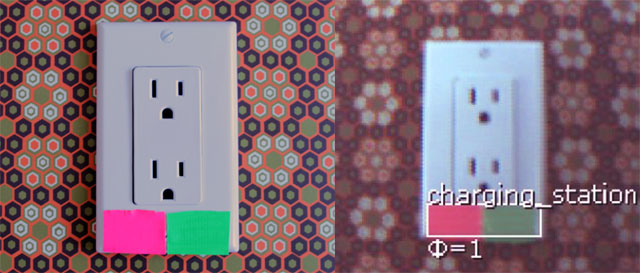Table of Contents
Color Connected Components
Purple dinosaurs (and other things)
Pixy2 uses a color-based filtering algorithm to detect objects called the Color Connected Components (CCC) algorithm. Color-based filtering methods are popular because they are fast, efficient, and relatively robust. Most of us are familiar with RGB (red, green, and blue) to represent colors. Pixy2 calculates the color (hue) and saturation of each RGB pixel from the image sensor and uses these as the primary filtering parameters. The hue of an object remains largely unchanged with changes in lighting and exposure. Changes in lighting and exposure can have a frustrating effect on color filtering algorithms, causing them to break. Pixy2’s filtering algorithm is robust when it comes to lighting and exposure changes.
Seven color signatures
Pixy2's CCC algorithm remembers up to 7 different color signatures, which means that if you have 7 different objects with unique colors, Pixy2’s color filtering algorithm will have no problem identifying them. If you need more than seven, you can use color codes (see below).
Hundreds of objects
Pixy2 can find literally hundreds of objects at a time. It uses a connected components algorithm to determine where one object begins and another ends. Pixy2 then compiles the sizes and locations of each object and reports them through one of its interfaces (e.g. SPI).
Teach it the objects you’re interested in
Pixy2 is unique because you can physically teach it what you are interested in sensing. Purple dinosaur? Place the dinosaur in front of Pixy2 and press the button. Orange ball? Place the ball in front of Pixy2 and press the button. It’s easy, and it’s fast.
More specifically, you teach Pixy2 by holding the object in front of its lens while holding down the button located on top. While doing this, the RGB LED under the lens provides feedback regarding which object it is looking at directly. For example, the LED turns orange when an orange ball is placed directly in front of Pixy2. Release the button and Pixy2 generates a statistical model of the colors contained in the object and stores them in flash. It will then use this statistical model to find objects with similar color signatures in its frame from then on.
Pixy2 can learn seven color signatures, numbered 1-7. Color signature 1 is the default signature. To teach Pixy2 the other signatures (2-7) requires a simple button pressing sequence.
Pixy2 "tracks" each object it detects
Once Pixy2 detects a new object, it will add it to a table of objects that it is currently tracking and assign it a tracking index. It will then attempt to find the object (and every object in the table) in the next frame by finding its best match. Each tracked object receives an index between 0 and 255 that it will keep until it either leaves Pixy2's field-of-view, or Pixy2 can no longer find the object in subsequent frames (because of occlusion, lack of lighting, etc.)
Tracking is useful when you want your program to keep tabs on a certain instance of an object, even though there may be several other similar objects in the frame.
What’s a “color code”?
A color code (CC) is two or more color tags placed close together. Pixy2 can detect and decode CCs and present them as special objects. CCs are useful if you have lots of objects you want to detect and identify (i.e. more than could be detected with the seven separate color signatures alone.)
A color code scheme with 2 tags and 4 different colors can differentiate up to 12 unique objects. CCs with 3, 4 and 5 tags and/or more different colors are possible and can allow for many, many more unique objects. (In fact, thousands of unique codes are possible by using CCs with 5 tags and 6 colors.)
Why Color Codes?
CCs are useful if you have lots of objects you want to detect and identify, more than could be detected with the seven separate color signatures alone. CCs also improve detection accuracy by decreasing false detections. That is, there is a low probability that specific colors will occur both in a specific order and close together. The drawback is that you need to place a CC on each object you’re interested in detecting. Often the object you’re interested in (yellow ball, purple toy) has a unique color signature and CCs aren’t needed. Objects with CCs and objects without CCs can be used side-by-side with no problems, so you are free to use CCs for some objects and not others.
CCs give you an accurate angle estimate of the object (in addition to the position and size). This is a computational “freebie” that some applications may find useful. The angle estimate, decoded CCs, regular objects and all of their positions and sizes are provided at 60 frames per second.
CCs might be particularly useful for helping a robot navigate. For example, an indoor environment with CCs uniquely identifying each doorway and hallway would be both low-cost and robust.
Color connected components API
The color connected components API can be found here.
Running color connected components in PixyMon
Information about running and configuring the color connected components program in PixyMon can be found here.
